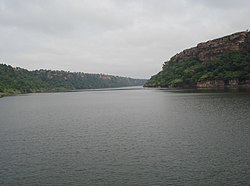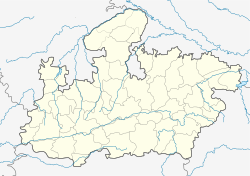Mandsaur
|
Mandsaur Dashpur |
|
|---|---|
| City | |

River Chambal in Gandhi Sagar Sanctuary
|
|
| Coordinates: 24°02′N 75°05′E / 24.03°N 75.08°ECoordinates: 24°02′N 75°05′E / 24.03°N 75.08°E | |
| Country | India |
| State | Madhya Pradesh |
| District | Mandsaur |
| Government | |
| • Mayor | Mr. Prahalad Bandhwar |
| Languages | |
| • Official | Hindi |
| Time zone | IST (UTC+5:30) |
| PIN | 458001 |
| Telephone code | 07422 |
| Vehicle registration | MP-14 |
| Website | www |
Mandsaur or Mandsour is a city in the Malwa region and district of Madhya Pradesh state of central India. It is the administrative headquarters of Mandsaur District. Mandsaur is rich in archaeological and historical heritage But what makes it famous is the temple of Lord Pashupatinath located on the bank of Shivna river. Its idol has parallel only in Nepal. The most common language is Malvi (Rajasthani and Hindi Mixed).It is also famous for large production of Opium around the world. The slate pencil industry is the main industry of the district.
The name Mandsaur evolved from Marhsaur, which originated from Marh and Saur (or Dasaur), two of the villages which merged in the town.The town was known as Dashapura in ancient times. The city consists of ten 'puras', which gave it the name Dashpura (ten puras).
The Mahabharata Book 2: Sabha Parva SECTION XXXI locates Trigartas along with Dasharnas, the Sivis, the Amvashtas, the Malavas, the five tribes of the Karnatas around Rohtak in Haryana as under:
Epigraphical discoveries have brought to light two ancient royal houses, who call themselves as Aulikaras and ruled from Dashapura (present-day Mandsaur). The first dynasty, who ruled from Dashapura from the beginning comprised the following kings in the order of succession: Jayavarma, Simhavarma, Naravarma, Vishvavarma and Bandhuvarma. Bandhuvarma was contemporary of Kumaragupta I. There is an inscription about Bandhuvarma at Mandsaur. The silk workers had constructed a Sun temple here which was repaired by Bandhuvarma in Samvat 493 (436 CE). This indicates that he was present there till 436 CE. The Risthal stone slab inscription discovered in 1983 has brought to light another Aulikara dynasty, which comprised the following kings in the order of succession: Drumavardhana, Jayavardhana Ajitavardhana, Vibhishanavardhana, Rajyavardhana and Prakashadharma. After Parakshadharma, the ruler of Mandsaur was Yashodharma, who is identified with Vishnuvardhana, who erected a pillar of victory at Bayana due to which Bayana’s name became Vijaygarh. In all probabilities, he was the son and immediate successor of Prakashadharma. Yashodharma Vishnuvardhana assumed the title of Samrat after he occupied the territories of Bandhuvarma. It is also mentioned that Yashodharma Vishnuvardhana had assumed the title of ‘Maharajadhiraja’ or Emperor.
...
Wikipedia

